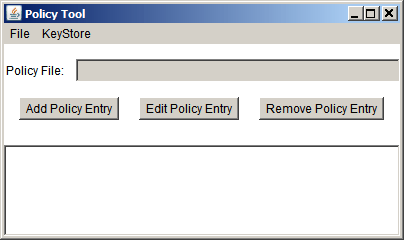Lesson: Signing Code and Granting It Permissions
Section: Steps for the Code Receiver
Subsection: Set Up a Policy File to Grant the Required Permission
The Java Tutorials have been written for JDK 8.Java教程是为JDK 8编写的。Examples and practices described in this page don't take advantage of improvements introduced in later releases and might use technology no longer available.本页中描述的示例和实践没有利用后续版本中引入的改进,并且可能使用不再可用的技术。See Java Language Changes for a summary of updated language features in Java SE 9 and subsequent releases.有关Java SE 9及其后续版本中更新的语言特性的摘要,请参阅Java语言更改。
See JDK Release Notes for information about new features, enhancements, and removed or deprecated options for all JDK releases.有关所有JDK版本的新功能、增强功能以及已删除或不推荐的选项的信息,请参阅JDK发行说明。
Start Policy Tool
To start Policy Tool, simply type the following at the command line:
policytool
This brings up the Policy Tool window. Whenever Policy Tool is started, it tries to fill in this window with policy information from what is sometimes referred to as the "user policy file," which by default is a file named .java.policy in your home directory. If Policy Tool cannot find the user policy file, it reports the situation and displays a blank Policy Tool window (that is, a window with headings and buttons but no data in it, as shown in the following figure.

You will create and work on a policy file other than the user policy file, since the lessons of this trail don't expect modifications to be made to your official user policy file.
Assuming that you see the blank Policy Tool window (if not, select New in the File menu), you can immediately proceed to create a new policy file.